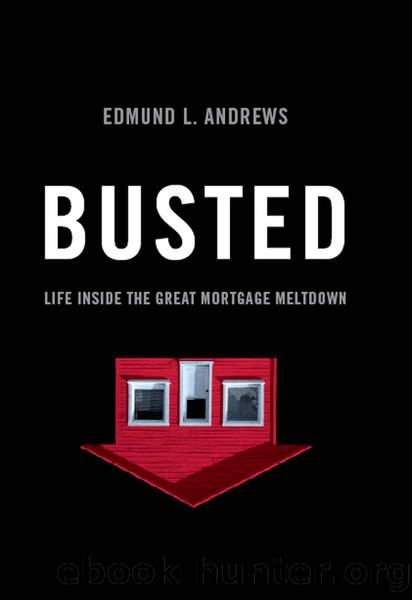Busted by Edmund L. Andrews

Author:Edmund L. Andrews
Language: eng
Format: epub
Publisher: W. W. Norton & Company
Published: 2009-05-15T00:00:00+00:00
The weird science was just beginning. Thanks to another raft of financial engineers, Fremontâs bundle of mortgages underwent a second round of alchemy that was even more surreal than the first. It was time for âcollateralized debt obligations.â
Why bother with a second round of alchemy? Because in order to make a subprime deal work, it wasnât enough to sell the triple-A slices that had been shined up and deodorized. You also had to sell the raunch-tranche at the bottom, and those were much nastier than original Fremont mortgages themselves. If nobody bought the malodorous 20 percent of bonds with all the risk, there wouldnât be anybody to shield those who bought the top 80 percent. Unfortunately, and contrary to what investors had come to believe, shifting the risk from one spot to another didnât mean it had disappeared. âItâs the law of conservation of misery,â said Tanya Styblo Beder, head of SBCC Group, a consulting firm that specializes in securitization. âYou can move the misery around, but it never goes away.â
JPMorgan had absolutely no trouble selling Fremontâs misery. Its buyers included hedge funds like Ellington Management; Wall Street firms like Lehman Brothers; and foreign banks like Royal Bank of Canada, Gulf International Bank in Bahrain, and Fortis Bank in Belgium. All of these institutions had created âmezzanine collateralized debt obligations,â or âmezz CDOs,â to buy up the raunch-tranches of subprime pools like FRE1.
A collateralized debt obligation was basically another pool like FRE1, with a similar structure of dividing risk into different slices. The difference was that a CDO generally bought the securities backed by subprime mortgages instead of buying subprime mortgages themselves. A mezz CDO focused specifically on the super-risky layers that one would have thought nobody wanted. CDOs had been around for more than a decade, but it wasnât until about 2002 that they started being used to finance mortgages. By 2006, as housing prices and subprime mortgages were both peaking, financial companies were cranking out more than $200 billion worth of new CDOs a year, according to JPMorgan.
What made the mezz CDOs so amazing was the way they repeated the same alchemy that JPMorgan Chase had used initially to create FRE1. Consider the case of something called Libertas Preferred Funding III, a CDO that started out with about $633 million in assets and had several million dollarsâ worth of FRE1âs raunch-tranches. Libertas III was the creation of a Philadelphia-based investment boutique called Cohen & Company. The fund had the unwanted slices from a roguesâ gallery of other lenders: Countrywide, IndyMac, New Century, Option One, First Franklin, and many others.
In other words, Libertas III contained the worst of the worst. So did its cousins, Libertas Preferred Funding I through V. Yet just like FRE1, about 80 percent of its bonds received triple-A ratings from Moodyâs, S&P, and Fitch in March 2006.
This seemed like more than alchemy. It was magic: JPMorgan Chase had turned the worst of the worst into the best of the best. Libertas actually outdid JPMorgan in
Download
This site does not store any files on its server. We only index and link to content provided by other sites. Please contact the content providers to delete copyright contents if any and email us, we'll remove relevant links or contents immediately.
| Buying & Selling Homes | Investments |
| Law | Mortgages |
| Sales |
Investing For Dummies by Eric Tyson(2477)
The Book on Rental Property Investing by Turner Brandon(1405)
The Book On Tax Strategies for the Savvy Real Estate Investor by Amanda Han & Matthew MacFarland(1343)
Every Landlord's Legal Guide by Janet Portman & Stewart Marcia & Ralph Warner(1330)
The Thibaults by Roger Martin Du Gard(1310)
Personal Finance For Dummies (9th Edition) by Eric Tyson(1274)
Real Estate Licensing Exams by Raymond D. Modglin(1152)
Investing 101 by Michele Cagan(1092)
Bill Bryson by At Home(1072)
The Real Book of Real Estate by Robert T. Kiyosaki(1039)
The Plaza by Julie Satow(1035)
Irrational Exuberance by Shiller Robert J. J(1030)
7 Steps to Wealth by John L. Fitzgerald(968)
Mortgages 101 by David Reed(962)
Real Estate Math Demystified by Steven P. Mooney(951)
The Business of Flipping Homes by William Bronchick(944)
Now I Sit Me Down by Witold Rybczynski(923)
Retail Development by Anita Kramer(911)
SAP Flexible Real Estate Management by Jayant Daithankar(908)
